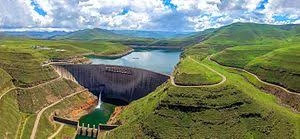Dams are hydraulic structure which are used for irrigation, flood control, hydropower generation etc. These are massive barriers build across the rivers. Based on the functions, structure and design, they are further divided into different types.
WHAT IS A DAM?
The dam is a barrier built across a stream or river. A pool is formed at the back of this barrier. The water collecting side is called the upstream side and the other side of the barrier is the downstream side.The water that forms in the top is called reservoir
USES OF DAMS:-
The water collected in the lake can be used for recreation, as drinking water supply or for irrigation to the surrounding agricultural land.The energy from this collected water can be used to turn the blades of a turbine to grind wheat.During floods, the use of dams will serve as a protection for towns and cities below the river. For more details CLICK HERE
TYPES OF DAMS:-
On the basis of the functions of the dams they are classified into
- Storage dams
- Detention dams
- Coffer dams
- Diversion dams
On the basis of the structural behaviour, They are classified into
- Gravity dams
- Buttress dams
- Arch dams
- Embankment dams
STORAGE DAMS:-
These are built to store water during a rainy season,when there is a large flow in the river. Many small dams spring up for later use during the dry summer. Storage dams may provide water supply or better habitat for fish and wildlife. They can be watered for hydropower generation, irrigation or flood control planning. Storage dams are the most common dams. Generally a dam means no storage dam.
DETENTION DAMS:-
Detention dams are being built for flood control. A detention dam interrupts river flow during floods. Thus the effect of sudden flooding is reduced to some extent. Depending on the carrying capacity of the downstream channel of the detention dam, the water stored in the reservoir is then released gradually at a controlled rate. The lower part of the dam is thus protected from flooding.
COFFER DAMS:-
This is a built in area around the construction site to avoid water, so construction can be done in a dry manner. During the construction of the dam, a coffer dam is built over the main dam to divert water into a diversion tunnel (or channel). When the river flow is not high during the construction of the dam, the site is usually surrounded by a Coffer dam and pumped dry. Thus the dam is constructed.
DIVERSION DAMS:-
A diversion dam is constructed to divert the water of the river into an off-tacking canal.They provide sufficient pressure to supply water to pits, canals or other convection systems. Such dams are used for irrigation and diversion from a stream to a remote storage reservoir. The diversion dam usually has a low elevation and a small storage pile upstream of it. A diversion dam is a type of storage ware that diverts water and makes small storage. Sometimes, the terms weirs and diversion dams are used synonymously
GRAVITY DAMS:-
The Gravity Dam is a structure that resists external forces with its own weight or self-weight. Gravity dams are usually made of wood or concrete.
Its self-weight resists various external forces, such as water pressure, rise pressure, wave pressure, ice pressure, and earthquake pressure, and it acts vertically downwards. Therefore, a good foundation is needed to build the Gravity Dam.
The cross-sectional shape of the gravity dam is approximately triangular. The infiltration gallery can be provided inside the dam to resist rising pressure. Sliding, twisting or breaking the toe can result in the failure of a gravity dam. Therefore, a high component of safety is recommended for the design of a gravity dam
BUTTRESS DAMS:-
Buttress dam contains a standing slab, a face slab, and a base slab. The face slab is provided with a slight inclination in the upstream part, supporting a series of columns that have nothing but support for this slab. The base slab acts as the basis for the entire dam, which is loaded from the batters and the face slab.
The buttress Dam is straight or curved in plan. The height of the dam is higher than the number of columns. These types of dams are preferred where the basic soil is very weak. You can use the available space between the piles for a variety of purposes, such as water treatment plant installation, power plant installation.
ARCH DAMS:-
An arch dam is enclosed by a plan with its convex upstream. The various forces coming to the dam resist its arch work. It is made of masonry or concrete, but requires less material compared to Gravity Dam.Loads coming to the dam are transferred to the dam abutments. Therefore, abutments must be strong and are usually used as natural forms such as hills. Arch dams generally prefer narrow valleys.
Arch Dam is economical if the length of the dam is less than its height. Therefore, these types of dams can be built at higher altitudes
EMBANKMENT DAMS:-
An embankment dam is a large artificial dam. It is usually created by the location and compaction of a complex semi-plastic hill of various compositions of mud, sand, clay, or rock. Its surface has a semi-wide waterproof natural enclosure and a dense, invisible core.











0 Comments
Please do not enter any spam link in comment box